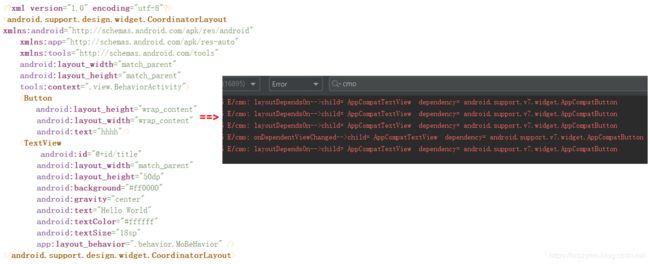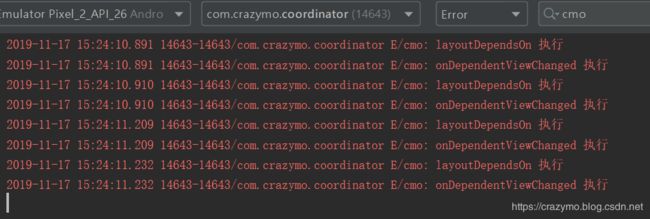Android 进阶——Material Design新控件之利用CoordinatorLayout协同多控件交互(七)
文章大纲
- 引言
- 一、CoordinatorLayout概述
- 二、CoordinatorLayout.LayoutParams概述
- 三、CoordinatorLayout.Behavior
- 1、Behavior概述
- 2、CoordinatorLayout.Behavior核心方法
- 2.1、layoutDependsOn方法
- 2.2、onDependentViewChanged方法
- 2.3、onDependentViewRemoved方法
- 2.4、onInterceptTouchEvent方法设置是否拦截触摸事件
- 2.5、onTouchEvent方法处理触摸事件
- 2.6、onMeasureChild方法测量使用Behavior的View尺寸
- 2.7、onLayoutChild方法重新布局使用Behavior的View
- 三、CoordinatorLayout的简单使用
- 1、引入CoordinatorLayout 依赖
- 2、继承CoordinatorLayout.Behavior实现自己的Behavior
- 3、使用CoordinatorLayout作为顶层布局,同时给对应的View配置Behavior使之变成主题View
- 4、在MainActivity中触发dependency View状态改变进行测试
- 四、CoordinatorLayout的核心流程解析
引言
前面系列文章总结了Material Design 兼容库提供大部分新控件的使用,Android L之前,如果希望一个ViewGroup里的独立的控件互相关联和交互,比如说侧滑菜单、可滑动删除的UI元素等效果,需要自己去实现交互逻辑,而在引入Material Design 兼容库之后就十分简单了,CoodinatorLayout就提供交互逻辑,系列文章链接:
- Android进阶——Material Design新控件之初识TabLayout(一)
- Android进阶——Material Design新控件之TabLayout制作可滚动的Tabs页面(二)
- Android进阶——Material Design新控件之Snackbar(三)
- Android进阶——Material Design新控件之TextInputLayout(四)
- Android进阶——Material Design新控件之FloatingActionButton(五)
- Android进阶——Material Design新控件之NavigationView(六)
- Android进阶——Material Design新控件之利用CoordinatorLayout协同多控件交互(七)
一、CoordinatorLayout概述
CoordinatorLayout继承自ViewGroup,可以看成是一个加强版的“FrameLayout”,在Android开发中提供的核心功能主要有:
- 在布局文件当中作为最顶层的布局容器控件
- 为CoordinatorLayout中的直接子控件提供特定的交互功能,相当于是给CoordinatorLayout里的直接子控件建立依赖关系,使得原本相对独立的控件,产生“依赖”联系,可以实现一个目标控件改变时,另一个也随着改变。
简而言之,CoordinatorLayout可以使得其直接子控件之间产生“依赖”联系,具体是通过变形的“观察者模式”实现的:
- 主题(被观察者角色)——配置了Behavior的子View(在布局文件中使用Behavior的全类名字符串(也可以@string/R.string.xxx形式引入)来配置View的app:layout_behavior属性
- 观察者角色—— 在绑定的Behavior的layoutDependsOn方法返回true时的dependency view。
当观察者View(位置、大小)改变时,就会触发Behavior的onDependentViewChanged方法(只有Dependency View 改变时才会触发)。
无论是主题还是观察者View,都必须是CoordinatorLayout内的直接子View。
二、CoordinatorLayout.LayoutParams概述
CoordinatorLayout.LayoutParams是CoordinatorLayout的内部类,和其他ViewGroup功能类似,在CoordinatorLayout的generateLayoutParams方法中直接调用构造方法进行初始化且在CoordinatorLayout.LayoutParams构造方法内部调用CoordinatorLayout的parseBehavior根据配置的Behavior的类名反射创建Behavior并赋值到mBehavior字段,然后再通过Behavior的onAttachedToLayoutParams方法Called when the Behavior has been attached to a LayoutParams instance.,所以除了保存CoordinatorLayout内的子控件的布局信息之外,还保存着对应的Behavior对象引用 mBehavior。
public class CoordinatorLayout extends ViewGroup implements NestedScrollingParent2 {
...
public static class LayoutParams extends MarginLayoutParams {
...
Behavior mBehavior;
LayoutParams(@NonNull Context context, @Nullable AttributeSet attrs) {
super(context, attrs);
final TypedArray a = context.obtainStyledAttributes(attrs,R.styleable.CoordinatorLayout_Layout);
this.gravity = a.getInteger(R.styleable.CoordinatorLayout_Layout_android_layout_gravity,Gravity.NO_GRAVITY);
mAnchorId = a.getResourceId(R.styleable.CoordinatorLayout_Layout_layout_anchor,View.NO_ID);
this.anchorGravity = a.getInteger(R.styleable.CoordinatorLayout_Layout_layout_anchorGravity,Gravity.NO_GRAVITY);
this.keyline = a.getInteger(R.styleable.CoordinatorLayout_Layout_layout_keyline,-1);
insetEdge = a.getInt(R.styleable.CoordinatorLayout_Layout_layout_insetEdge, 0);
dodgeInsetEdges = a.getInt(R.styleable.CoordinatorLayout_Layout_layout_dodgeInsetEdges, 0);
mBehaviorResolved = a.hasValue(R.styleable.CoordinatorLayout_Layout_layout_behavior);
if (mBehaviorResolved) {
mBehavior = parseBehavior(context, attrs, a.getString(R.styleable.CoordinatorLayout_Layout_layout_behavior));
}
a.recycle();
if (mBehavior != null) {
// If we have a Behavior, dispatch that it has been attached
mBehavior.onAttachedToLayoutParams(this);
}
}
}
...
}
三、CoordinatorLayout.Behavior
1、Behavior概述
CoordinatorLayout.Behavior是CoordinatorLayout的抽象泛型内部类,Behvaior 本身并不具备具体的业务功能,本质上就只是为了进行解耦的而封装的一个交互接口集合类,而CoordinatorLayout可以借助Behavior使得独立的子View可以产生交互,是因为CoordinatorLayout内部把事件分发至Behavior,让Behavior具有可以控制其他子View的效果了,也是CoordinatorLayout中核心的设计,也正是因为这个CoordinatorLayout.Behavior使得CoordinatorLayout中的直接子控件间可以产生联系,CoordinatorLayout.Behavior可以理解为事件分发的传送渠道(并不负责具体的任务),只是负责调用对应子View的相关方法,parseBehavior方法根据配置的Behavior的类名反射创建Behavior并赋值到mBehavior字段,这是继承Behavior时必须要重写两个参数的构造方法的原因。通俗来说,Behavior 设置在谁身上,就可以通过Behavior来改变它对应的状态,观察者改变时,主题也跟着改变。
2、CoordinatorLayout.Behavior核心方法
CoordinatorLayout.Behavior中最核心的方法只有三个:layoutDependsOn方法、onDependentViewChanged方法和onDependentViewRemoved方法,通过这三个方法就可以实现直接子View之间的交互,至于其他方法是处理到其他业务情况的时候,比如说嵌套滑动、重新布局等等。
2.1、layoutDependsOn方法
当进行Layout请求的时候就会触发执行,给CoordinatorLayout中的直接子控件设置了对应的Behavior之后,绘制时至少会执行一次,表示是否给配置了Behavior 的CoordinatorLayout直接子View 指定一个作为观察者角色的子View,返回true则表示主题角色child view的观察者是dependency view, 当观察者角色View状态(大小、位置)发生变化时,不管被观察View 的顺序怎样,被观察的View也可监听到并回调对应的方法;反之则两者之间没有建立联系。简而言之,这个方法的作用是配置了Behavior的主题子控件被符合哪些条件逻辑的子控件观察的(即作为主题的观察者之一)(Determine whether the supplied child view has another specific sibling view as a layout dependency)。
/**
* 用于给配置了Behavior的View(主题) 指定一个观察者角色的View,返回true则dependency 为主题的观察者
* @param parent child和dependency view的外层父布局
* @param child 绑定behavior 的View (观察者)
* @param dependency 被观察者的view (主题)
* @return 如果child 是观察者观察的View 返回true,否则返回false
*/
@Override
public boolean layoutDependsOn(CoordinatorLayout parent, View child, View dependency) {
Log.e("------>","layoutDependsOn:child= "+child.getClass().getName()
+" dependency= "+dependency.getClass().getName());
//依次判断dependency 是否符合条件,
if(dependency instanceof Button){
return true;
}
return super.layoutDependsOn(parent, child, dependency);
}
比如在CoordinatorLayout里的某一个子View配置了Behavior之后,CoordinatorLayout在布局时会循环去查找其所有的直接子View,逐一去判断这个子View是否可以作为主题的观察者,所以当CoordinatorLayout里有2个直接子控件时layoutDependsOn方法会触发3次(触发时机是处理layout request时,包含第一次绘制时和View改变时触发),如果打印dependency view的名称,你会看到CoordinatorLayout里所有的直接子View都会打印一遍(除了主题View)。
2.2、onDependentViewChanged方法
当且仅当Dependency View 状态(位置、大小等)改变时就会触发,返回true则表示Behavior改变了主题的状态,可能会执行多次,当然第一次绘制到布局上也算是状态改变时,所以自然也会触发,至于当监听到改变之后,如何去实现什么样的效果则由我们自己去开发实现。
/**
* 当被观察者的View 状态(如:位置、大小)发生变化时就会触发执行
* @return true if the Behavior changed the child view's size or position, false otherwise
*/
@Override
public boolean onDependentViewChanged(CoordinatorLayout parent, View child, View dependency) {
Log.e("------>","onDependentViewChanged:child= "+child.getClass().getName()
+" dependency= "+dependency.getClass().getName());
return super.onDependentViewChanged(parent, child, dependency);
}
可以在View改变时及时得知,以下为部分运行日志:
2.3、onDependentViewRemoved方法
当依赖的Dependency View被移除时触发回调(Respond to a child’s dependent view being removed.)
/**
* Respond to a child's dependent view being removed.
* @param parent the parent view of the given child
* @param child the child view to manipulate
* @param dependency the dependent view that has been removed
*/
public void onDependentViewRemoved(@NonNull CoordinatorLayout parent, @NonNull V child,
@NonNull View dependency) {
}
2.4、onInterceptTouchEvent方法设置是否拦截触摸事件
设置是否拦截触摸事件,返回true则表示当前Behavior会拦截触摸事件,不会分发到CoordinatorLayout内的子View下了。(Respond to CoordinatorLayout touch events before they are dispatched to child views.)
public boolean onInterceptTouchEvent(@NonNull CoordinatorLayout parent, @NonNull V child,
@NonNull MotionEvent ev) {
return false;
}
2.5、onTouchEvent方法处理触摸事件
public boolean onTouchEvent(@NonNull CoordinatorLayout parent, @NonNull V child,
@NonNull MotionEvent ev) {
return false;
}
2.6、onMeasureChild方法测量使用Behavior的View尺寸
/**
* Called when the parent CoordinatorLayout is about to measure the given child view.
* @param child the child to measure
* @return true if the Behavior measured the child view, false if the CoordinatorLayout
* should perform its default measurement
*/
public boolean onMeasureChild(@NonNull CoordinatorLayout parent, @NonNull V child,
int parentWidthMeasureSpec, int widthUsed,
int parentHeightMeasureSpec, int heightUsed) {
return false;
}
2.7、onLayoutChild方法重新布局使用Behavior的View
/**
* Called when the parent CoordinatorLayout is about the lay out the given child view.
* @return true if the Behavior performed layout of the child view, false to request default layout behavior
*/
public boolean onLayoutChild(@NonNull CoordinatorLayout parent, @NonNull V child,
int layoutDirection) {
return false;
}
三、CoordinatorLayout的简单使用
1、引入CoordinatorLayout 依赖
dependencies {
def coordinatorlayout_version = "1.0.0"
implementation "androidx.coordinatorlayout:coordinatorlayout:$coordinatorlayout_version"
}
2、继承CoordinatorLayout.Behavior实现自己的Behavior
- 必须重写形参列表为(Context context, AttributeSet attrs)的构造方法
- 重写layoutDependsOn方法
- 重写onDependentViewChanged方法
/**
* 此Behavior 将要被绑定到TextView上,用于改变TextView的UI效果
* @author : Crazy.Mo
*/
public class TextColorBehavior extends CoordinatorLayout.Behavior<TextView> {
//避免因为CoordinatorLayout的onLayout执行时,一开始就调用了Behavior的onLayout造成,还未开始交互就一直执行了onDependentViewChanged
private boolean isFirst=true;
/**
* 必须重写,否则肯定报错
* @param context
* @param attrs
*/
public TextColorBehavior(Context context, AttributeSet attrs) {
super(context, attrs);
}
/**
* 这个方法是响应layout请求的,将至少调用一次,返回true时,child和dependency建立了依赖联系
* 即child是依赖dependency的
* @param parent
* @param child
* @param dependency
* @return
*/
@Override
public boolean layoutDependsOn(@NonNull CoordinatorLayout parent, @NonNull TextView child, @NonNull View dependency) {
//确定什么样的dependency 才有资格做child的观察者,逻辑由你自己决定
if(dependency instanceof Button){
return true;
}
return false;
}
/**
* 当dependency 的状态改变时就会触发
* @param parent
* @param child
* @param dependency
* @return
*/
@Override
public boolean onDependentViewChanged(@NonNull CoordinatorLayout parent, @NonNull TextView child, @NonNull View dependency) {
///当dependency 的状态改变时,就会触发这个方法执行,在这个方法你可以拿到主题View和观察者View,所以想要实现什么样的效果,完全由你决定,彻彻底底地解耦
if(!isFirst){
if(child.getId()==R.id.txt_demo2) {
child.setX(dependency.getX() + 20);
child.setY(dependency.getY() + 150);
child.setTextColor(Color.GREEN);
}else if(child.getId()==R.id.txt_demo){
child.setX(dependency.getX() + 20);
child.setY(dependency.getY() + 350);
child.setTextColor(Color.BLUE);
}
//当然你可以同时改变dependency的状态
// dependency.setX(child.getX()+20);
// dependency.setY(child.getY()+150);
/// dependency.setBackgroundColor(Color.RED);
}
isFirst=false;
return true;
}
}
在CoordinatorLayout中一般对于一个主题View来说一次只能设置绑定一个Behavior(且绑定的Behavior并不是被独享,其他主题View也可以绑定同一个Behavior),但可以被多个观察者所监听,而一个观察者可以同时监听多个主题View。
package com.crazymo.coordinator;
import android.content.Context;
import android.graphics.Color;
import android.util.AttributeSet;
import android.util.Log;
import android.view.View;
import android.widget.Button;
import android.widget.TextView;
import androidx.annotation.NonNull;
import androidx.coordinatorlayout.widget.CoordinatorLayout;
/**
* @author : Crazy.Mo
*/
public class TextBehavior extends CoordinatorLayout.Behavior<TextView> {
private boolean isFirst=true;
/**
* 必须重写,否则肯定报错
* @param context
* @param attrs
*/
public TextBehavior(Context context, AttributeSet attrs) {
super(context, attrs);
}
/**
* 这个方法是响应layout请求的,将至少调用一次,返回true时,child和dependency建立了依赖联系
* 即child是依赖dependency的
* @param parent
* @param child
* @param dependency
* @return
*/
@Override
public boolean layoutDependsOn(@NonNull CoordinatorLayout parent, @NonNull TextView child, @NonNull View dependency) {
if(dependency instanceof Button){
return true;
}
return false;
}
@Override
public boolean onDependentViewChanged(@NonNull CoordinatorLayout parent, @NonNull TextView child, @NonNull View dependency) {
if(!isFirst){
child.setX(dependency.getX()+20);
child.setY(dependency.getY()+250);
child.setTextColor(Color.RED);
}
isFirst=false;
return true;
}
}
上面定义了两个Behavior。
3、使用CoordinatorLayout作为顶层布局,同时给对应的View配置Behavior使之变成主题View
使用CoordinatorLayout一定要给对应的主题View配置app:layout_behavior属性,否则就没有必要使用CoordinatorLayout。
<androidx.coordinatorlayout.widget.CoordinatorLayout xmlns:android="http://schemas.android.com/apk/res/android"
xmlns:app="http://schemas.android.com/apk/res-auto"
xmlns:tools="http://schemas.android.com/tools"
android:layout_width="match_parent"
android:layout_height="match_parent"
tools:context=".MainActivity">
<TextView
android:id="@+id/txt_demo"
app:layout_behavior=".TextColorBehavior"
android:layout_width="wrap_content"
android:layout_height="wrap_content"
android:layout_gravity="top"
android:text="我是主题View(被观察者)" />
<TextView
android:id="@+id/txt_demo2"
app:layout_behavior=".TextColorBehavior"
android:layout_width="wrap_content"
android:layout_height="wrap_content"
android:layout_gravity="left|center"
android:text="我是主题View2(被观察者)" />
<TextView
android:id="@+id/txt_demo3"
app:layout_behavior=".TextBehavior"
android:layout_width="wrap_content"
android:layout_height="wrap_content"
android:layout_gravity="right|center_horizontal"
android:text="我是主题View3(被观察者)" />
<Button
android:id="@+id/btn_demo"
android:layout_width="wrap_content"
android:layout_height="wrap_content"
android:layout_gravity="bottom"
android:text="观察者" />
androidx.coordinatorlayout.widget.CoordinatorLayout>
4、在MainActivity中触发dependency View状态改变进行测试
此处模拟的是当dependency View状态改变时,其他主题View跟随者改变的简单效果,当观察者移动时主题TextView紧跟其下方移动。
public class MainActivity extends AppCompatActivity {
@Override
protected void onCreate(Bundle savedInstanceState) {
super.onCreate(savedInstanceState);
setContentView(R.layout.activity_main);
findViewById(R.id.btn_demo).setOnTouchListener(new View.OnTouchListener() {
@Override
public boolean onTouch(View v, MotionEvent event) {
if(event.getAction()==MotionEvent.ACTION_MOVE){
v.setX(event.getRawX()-v.getWidth()/2);
v.setY(event.getRawY()-v.getHeight()/2);
}
return true;
}
});
}
}
如下图所示当我按着观察者Button移动时候,三个主题TextView都显示在Button的下方且跟着移动:
通俗总结就是:CoordinatorLayout里的任何直接子View具有随时监听到对方的状态改变的能力。
四、CoordinatorLayout的核心流程解析
未完待续,篇幅问题见下篇文章。

